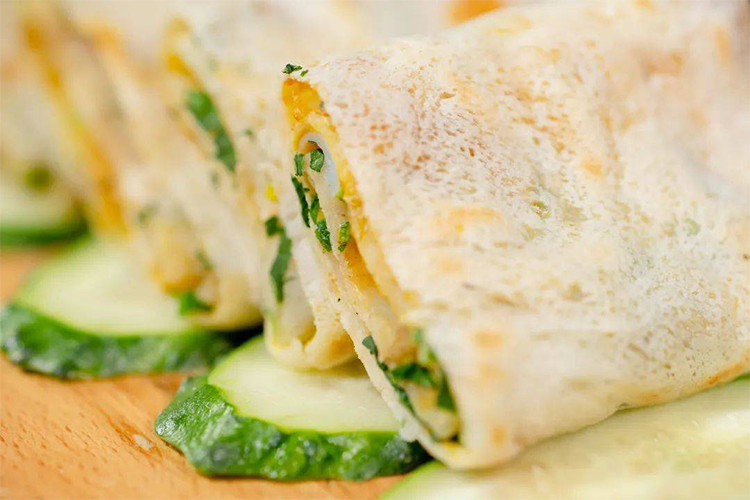Xinchang Spring Pancake: Jiangnan Rice Crepe Delight
Cradled in the Tianmu Mountains, Xinchang in Zhejiang Province is a millennia-old county famed for its scenic beauty—and for a traditional flavor that awakens all the senses: the Xinchang spring pancake. This is no ordinary flatbread but an edible sheet, as translucent as a cicada’s wing and soft yet springy like fine silk. In the cool morning alleys, steam and the scent of rice mingle as a vendor deftly spreads rice batter on a heated flat pan. For travelers exploring Jiangnan towns, a filled spring pancake is a delicious key to authentic local life.
1. One thin pancake that carries Ming and Qing era everyday life
The history of Xinchang spring pancake is intertwined with local rice culture and stretches back to the Ming and Qing dynasties. In this farming county, rice was life. Ancestors cherished every grain and ground soaked rice into batter to make thin cakes on pottery or iron pans—early forms of the spring pancake. Once a simple staple for farmers in the fields or students on exam journeys, it carried practical wisdom.
Over time the pancake evolved from plain sustenance into a seasonal and everyday snack. The word “spring” suggests the fresh feeling of milky rice batter and ties to the Lichun tradition of “biting the spring.” In Xinchang, eating spring pancake is more than filling the stomach; it’s a cultural ritual linking past and present.

2. Rice batter as the brush, the pan as canvas: the artisan’s craft
The exceptional taste of Xinchang spring pancake comes from exacting ingredients and craftsmanship. Its soul is local early indica rice, with lower stickiness and higher amylose for that soft-yet-pliable texture that resists tearing. Rice is soaked overnight, then milled into a silky batter. Water-to-rice ratios, soaking time and grinding fineness—all are controlled by the master vendor’s experience.
Cooking is a visual performance. A preheated flat pan (aozi) waits at the perfect temperature. The vendor ladles batter into the center and uses a bamboo rake to spread it outward in a smooth circle, like a painter’s stroke. In seconds steam rises, the pancake edge lifts slightly, and a white, translucent, supple crepe is born. The process flows like water—skill and timing in harmony.

3. A symphony on the palate: crisp, tender, savory layers
Half the appeal is the pancake; the other half is its “wrap everything” philosophy. Eaten plain, the crepe offers mild rice fragrance and gentle chew. But the classic way is to turn this blank canvas into a layered bite.
The most iconic combination—sometimes called the “spring pancake trio”—includes freshly fried crispy dumplings, crunchy-yet-tender stinky tofu, and juicy fried tofu puffs. Add thin slices of braised pig head, shredded egg, crisp cucumber sticks and spicy scallion strips. Brush on a swipe of sweet bean paste or piquant chili sauce to taste.
One bite delivers a harmonious collision: the crepe’s soft chew, the dumpling’s crunch, the pungent richness of stinky tofu, the fresh crispness of vegetables and the complex tang of sauces. Cold and hot, soft and crisp, mild and bold—these contrasts create irresistible flavor dynamics.

4. Eat like a local: a simple guide to enjoying Xinchang spring pancake
- Best time: Spring pancakes are local favorites for breakfast and afternoon snacks. Vendors often open by 5–6 a.m. and continue until evening. Start your day with a steaming set or enjoy one to recharge in the afternoon.
- Where to go: The best stalls are humble street vendors, not fancy restaurants. Head to old streets in Xinchang town—around Zhonglou South Street and Xizhen Road—where queues form beside steaming pans.
- Ordering tips: Ask for the “full set” to try all classic fillings, or customize by choosing your preferred items. Tell the vendor your sauce preference—sweet, spicy, or both—and whether you want extra heat.
- How to eat: Eat quickly while hot so the crepe stays tender and the fried items remain crisp. Hold with both hands and bite from the bottom up to get every layer in one mouthful.

5. Traveler tips: blend in easily with local food culture
- Language tip: The word for pancake, is pronounced bing (third tone). (roll spring pancake) is pronounced juǎn chūn bǐng.
- Drink pairings: Balance the rich flavors with a cup of local green tea (such as Dafu Longjing) or a light seaweed soup to refresh the palate.
- Cultural experience: Many stalls prepare the pancakes in the open—pause to watch the vendor’s rhythmic spreading technique. It’s a great way to observe local life.
- Nearby sights: Xinchang sits on Zhejiang’s Tang Poetry Road. After your pancake, visit Dafosi Temple or the Chuanyan nineteen peaks to enjoy local culture and scenery.

6. A taste of home: an easy home recipe to recreate Jiangnan spring at home
Home-style spring pancake recipe:
- Ingredients: 150 g glutinous-style rice flour, 50 g wheat starch (or mung bean starch), about 400 ml water, pinch of salt.
- Batter: Mix the flours and slowly whisk in water to a smooth, milk-like batter. Rest 30 minutes.
- Cook: Heat a non-stick skillet over low heat, brush lightly with oil. Pour a ladle of batter, tilt the pan to spread thinly.
- Finish: When the edges lift and the center sets, gently flip or lift off the crepe.
- Fill: Use your favorite fillings—stir-fried potato threads, ham strips, cucumber sticks, shredded egg—and a smear of sauce before rolling.
Home versions won’t perfectly match the local rice fragrance and chew, but they capture the spirit of Jiangnan spring.
Xinchang spring pancake is more than a snack; it’s a flavor map that wraps the county’s people, history and craft. Born from Ming and Qing everyday life, refined by artisans, and savored by modern diners, this thin rice crepe embodies a generous, inclusive food philosophy. When you visit, follow the rice aroma to that steamy stall, take a warm set into your hands—and taste not just crisp and savory contrasts, but the living pulse of Jiangnan under Tianmu Mountain.


